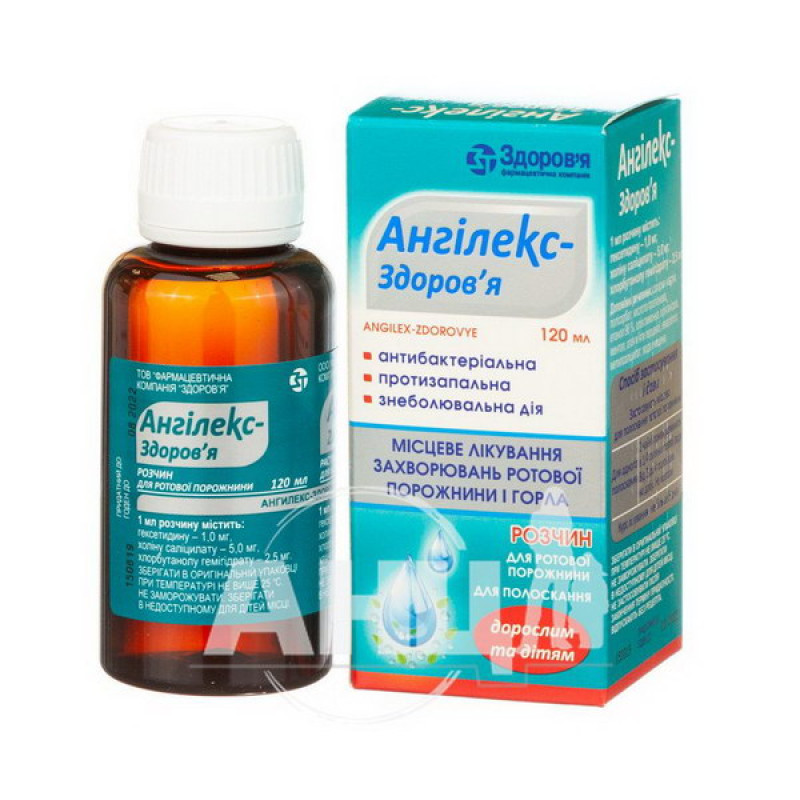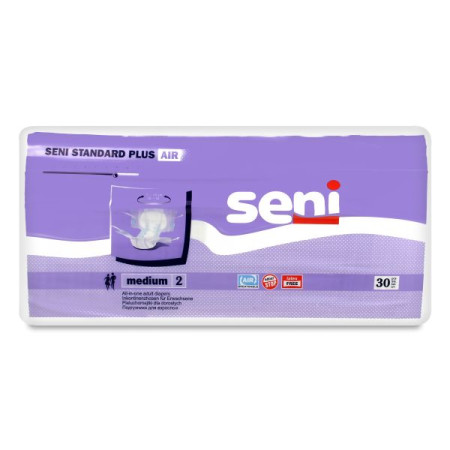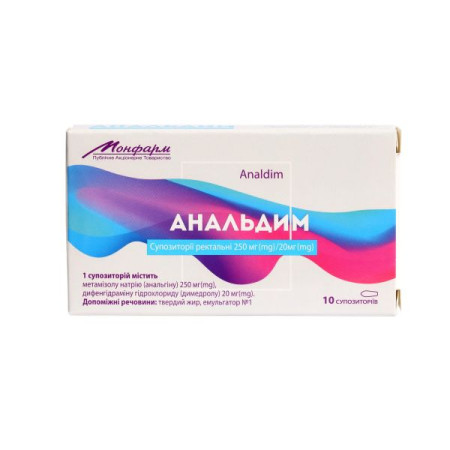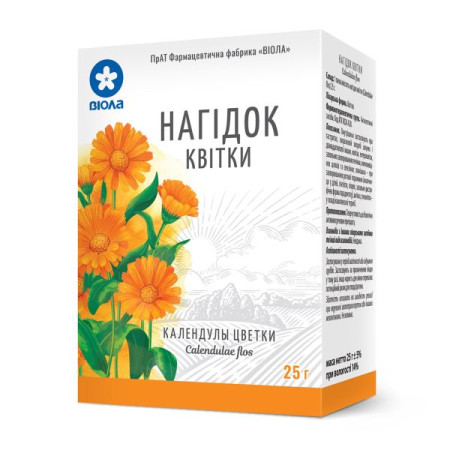Angilex-Health oral solution bottle 120 ml
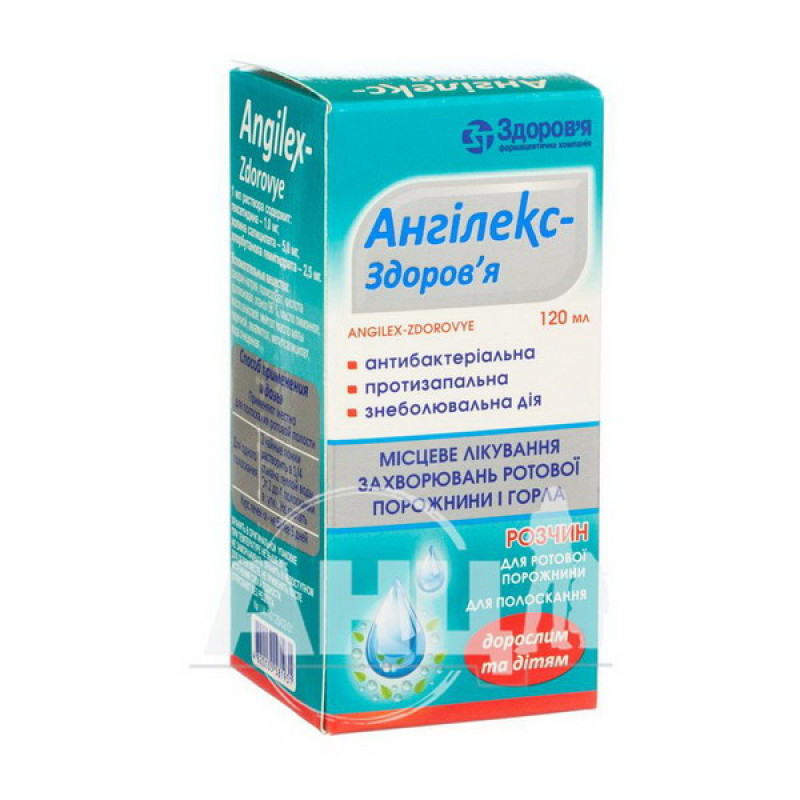
Pharmacological properties
Pharmacodynamics. The properties of the drug are due to the action of its three active ingredients - hexetidine, choline salicylate, and chlorobutanol hemihydrate.
Antibacterial and antifungal action is due to Hexetidine, which has antibacterial activity against gram-positive and gram-negative microorganisms (both aerobes and anaerobes). In relation to aerobic microorganisms, it has mainly a bacteriostatic effect and a weak bactericidal effect. On anaerobic microorganisms, hexetidine has a pronounced bactericidal effect. The mechanism of action of hexetidine is based on competitive substitution of thiamine: the structure of hexetidine is similar to the structure of thiamine, which is necessary for the growth of microorganisms.
The anti-inflammatory effect is due to choline salicylate, which belongs to the group of non-steroidal anti-inflammatory drugs and has analgesic, antipyretic and anti-inflammatory effects.
Analgesic activity is also due to the local anesthetic chlorobutanol, used in otolaryngology (nose drops, rinses) and dentistry (applications and irrigation) mainly as an analgesic.
Pharmacokinetics. Active substances are fixed on the mucous membrane of the oral cavity, from where they are then gradually released.
Indication
Local treatment of diseases and inflammatory processes of the oral cavity and pharynx in adults and children over 2.5 years of age: gingivitis, stomatitis; periodontitis; aphthae and pain during teething; postoperative care of the oral cavity; tonsillitis, acute and chronic tonsillitis, pharyngitis, laryngitis.
Application
The solution is used as a local mouthwash.
For one mouthwash: Dissolve 2 teaspoons of the preparation in ¼ cup of warm water. 2 to 4 rinses per day. Do not swallow.
The spray is used for irrigation of the oral cavity.
Adults: 1 spray 4-6 times a day
Children aged 2.5 to 15 years: 1 spray 2-3 times a day.
The course of treatment is no more than 5 days.
Contraindication
Do not use in children under 2.5 years of age. Do not use if you are allergic to the components of the drug.
Side effects
Allergic reactions: irritation, skin reactions. In this case, treatment must be discontinued.
Special instructions
Long-term use is not recommended, as it may lead to a disruption of the microbial balance in the mouth and throat.
Use during pregnancy or breastfeeding. During pregnancy and breastfeeding, the drug is used only as prescribed by a doctor and only if the benefit of using the drug for the mother outweighs the risk to the fetus.
The ability to influence the reaction speed when driving vehicles or working with other mechanisms. Does not affect.
Children. Used in children over 2.5 years of age. The safety of the drug in children younger than 2.5 years of age has not been studied.
Interactions
Do not use simultaneously with drugs containing antiseptics.
Overdose
There have been no reports of overdose.
Storage conditions
At a temperature not exceeding 25 °C. Do not freeze.
Current information
Angilex is a drug often prescribed by otolaryngologists, dentists and general practitioners. It belongs to the group of medicines used for throat diseases, and is available from pharmacies without a doctor's prescription.
It contains (according to the instructions of the Ministry of Health) the following active ingredients: hexetidine, choline salicylate, chlorobutanol hemihydrate. It is available in the form of a spray and solution for the oral cavity.
Principles of use, mechanism of action of the drug AngilexAngilex is a drug that has a local antiseptic, anti-inflammatory, analgesic effect. Its active ingredient hexetidine has a bacteriostatic effect on aerobic microorganisms, the bactericidal effect is weak. But it has a bactericidal effect on anaerobes. The mechanism of action is a competitive interaction with thiamine: in its chemical structure, hexetidine is similar to thiamine, which is necessary for the growth of microorganisms. Anti-inflammatory and analgesic effects are achieved by blocking the COX enzyme. Choline salicylate is responsible for the anti-inflammatory activity of the drug, and also exhibits analgesic and antipyretic effects. The analgesic effect is provided by chlorobutanol.
The use of the drug Angilex is advisable in complex therapy for inflammatory diseases of the oropharynx, for example, tonsillitis, pharyngitis. Angilex is effective for periodontal diseases, stomatitis, fungal lesions of the oral cavity (complex therapy). It is prescribed as part of complex therapy for acute respiratory viral infections (for sore throat).
Therapeutic effect of the active ingredients of the drug AngilexHexetidine
Hexetidine is an antiseptic, a pyrimidine derivative, its effectiveness and safety when used topically have been confirmed in many studies.
In one study, the therapeutic effect of 0.1% solution and 0.2% aerosol of hexetidine for topical use was studied. It was found that hexetidine is a safe antiseptic with a wide spectrum of antibacterial activity in vitro and in vivo. It also has local anesthetic, astringent and deodorizing effects. In addition, it prevents the formation of microbial biofilms. Pathogenic microorganisms have low resistance to hexetidine (Capic E. et al, 2002). The above-described characteristics of hexetidine explain the effectiveness of the drug Angilex and its purpose in the treatment of infections of the oral cavity and throat.
One study compared the efficacy of 0.1% hexetidine and 0.1% chlorhexidine in the form of a mouthwash. These solutions were administered to patients with gingivitis or periodontitis. The therapeutic efficacy and side effects of both drugs were studied. The study concluded that hexetidine solution is an alternative to chlorhexidine solution, as it is no less effective in the treatment of the above diseases. The side effects of both substances were similar, but hexetidine had a lesser effect on changes in the color of tooth enamel (Ernst CP et al., 2005).
However, when prescribing drugs containing hexetidine, it should be borne in mind that there are studies that confirm a large number of side effects when using hexetidine. In them, hexetidine was compared with placebo and chlorhexidine in the treatment of gingivitis. The authors of the new studies emphasize that chlorhexidine should still be used, since it is better tolerated by patients (Afennich F. et al., 2011). At the same time, in a study comparing the therapeutic efficacy of fluconazole and hexetidine as a local therapy for oral candidiasis in patients with dentures, it was found that hexetidine is better tolerated by patients than fluconazole and causes fewer side effects. Therapy of oral candidiasis Hexetidine was effective and, given its greater safety, it was recommended to prescribe hexetidine (Koray M. at al., 2005).
In dental practice, hexetidine has been studied as a drug for the prevention of caries. It reduces the formation of dental plaque. Active substances used for the prevention of caries should prevent the formation of biofilms of pathogenic bacteria without affecting the biological balance of the oral microflora. The appointment of antimicrobial drugs is primarily characteristic of secondary and tertiary prevention (to prevent recolonization by pathogenic microorganisms) to prevent disease recurrence. The results of these studies indicate that hexetidine is able to inhibit the development and maturation of pathogenic biofilms, as well as affect bacterial metabolism (Baehni PC, Takeuchi Y., 2003).
Supragingival plaque (tartar) is one of the problems in dentistry. Reducing its formation is a key point in the prevention of caries and periodontal diseases. Only mechanical removal of plaque during tooth brushing is not always effective. The properties of hexetidine to inhibit the formation of plaque were studied by a group of European scientists. According to the results of the studies, it was concluded that hexetidine slows down the formation of plaque, therefore it is used to prevent the development of gingivitis, and also has an anti-inflammatory effect and, therefore, can be used in the complex therapy of this disease. Conclusions were also made about the safety of the drug for wide clinical use. Hexetidine is effective against C. albicans, which often colonizes dentures. It was also found that hexetidine can be used in dental practice both in the form of a mouthwash solution and in the form of an oral spray. To prevent colonization of dentures by pathogenic microorganisms, it has been suggested to treat them by immersing them in a 0.1% hexetidine solution overnight (8 hours) (Aoun G et al., 2005).
Pathogenic microorganisms are the cause of inflammatory processes in the oral cavity and pharynx. In one study conducted in vitro, the activity of 4 antiseptics (cetyltrimethylammonium naproxenate, chlorhexidine, benzydamine, hexetidine) was compared with 4 antibiotics (amoxicillin, amoxicillin and clavulanic acid, clarithromycin, cefaclor). The effect of drugs of both groups on microorganisms colonizing the oropharynx and respiratory tract, including Streptococcus pyogenes and Streptococcus pneumoniae, was studied. This study showed that the selected group of bacteria was more sensitive to the group of antiseptics than to amoxicillin and amoxicillin and clavulanic acid. As a result of the study, it was found that the above-described antiseptics can be used against pathogenic microorganisms of the oral cavity and throat (Pilloni AP et al., 2002).
Hexetidine has also been used to treat endotracheal tubes during mechanical ventilation in intensive care unit patients. The results of the study concluded that the resistance of hexetidine-containing PVC 1% to microbial adhesion was higher than that of native PVC. Therefore, it is assumed that this method may reduce the incidence of ventilator-associated pneumonia (a special form of pneumonia that occurs in patients on mechanical ventilation) (Jones DS et al., 2002).
Choline salicylate is an effective and well-tolerated anti-inflammatory drug, known since the 1960s, when it was also used as an antipyretic (Broh-Kahn Rh., 1960). Choline salicylate is also used to treat rheumatic diseases, primarily rheumatoid arthritis, as part of ear and eye drops, for the treatment of otitis media, gingivitis, and plaque removal (Scully FJ, 2010).
Choline salicylate has proven itself positively in the treatment of inflammatory gum diseases (Brodniewicz Z. et al., 1986), and due to its analgesic properties - in the treatment of ulcerative lesions of the oral cavity (Daniel A. et al., 1960).
As an effective anti-inflammatory and analgesic drug, choline salicylate is recommended to be included in the complex therapy of acute catarrhal otitis media (Razvozzhaev Leonid Mikhailovich A.A. et al., 2012).
One study examined the irritant effect of 2% choline salicylate in the form of eye drops. They were applied to rabbit corneal cells for 5 min. The viability of the corneal cells was then determined. The study found that the drug had low cytotoxicity. After its application, cell viability was over 70% (Wroblewska K. et al., 2015).
An interesting study was conducted in 1986. Previously, it was believed that choline salicylate could be prescribed to individuals with hypersensitivity to acetylsalicylic acid and other nonsteroidal anti-inflammatory drugs. However, cases of hypersensitivity and exacerbation of bronchial asthma after taking choline salicylate have been described. Thus, it can be concluded that the development of a cross-hypersensitivity reaction is possible (Chudvin D.S. et al., 1986). Accordingly, Angilex should be prescribed to such patients with extreme caution.
There is also information that the use of drugs containing choline salicylate for the treatment of oral diseases can lead to the development of refractory gastric ulcers (Lim YC et al., 2014). This side effect is especially relevant when self-medicating with drugs containing this active ingredient. Patients should be informed about the possible ulcerative lesions of the gastrointestinal tract as a side effect of drugs containing choline salicylate, as well as the danger of their uncontrolled use.
chlorobutanol hemihydrate
Chlorobutanol is a component of some sedative drugs and anesthetics. When used internally, it has a sedative effect. Locally, it is prescribed as an antiseptic, has a distracting effect, and is characterized by moderate anti-inflammatory properties.
In studies of the toxicity of chlorobutanol, it was found that this active substance has low toxicity. It is part of a large number of medicines. However, it should be prescribed with special caution to patients with impaired liver and kidney function. Speech disorders, dysarthria, drowsiness, and hemodynamic disorders may occur. The development of toxic effects is possible with prolonged uncontrolled use of drugs containing chlorobutanol hemihydrate (Nordt SP et al., 1996).
It should be remembered that in vitro studies, chlorobutanol had adverse effects on mouse embryonic tissues. In studies in mice, it was found to cross the placenta and have toxic effects on embryonic tissues (Smith WS et al., 1997).
conclusionAngilex is a drug whose active ingredients are selected in such a way that the therapeutic effect of each is complementary and mutually reinforcing. However, it must be remembered that the drug has contraindications and side effects, so before using it you should consult a doctor, even though it is an over-the-counter drug.
There are no reviews for this product.
There are no reviews for this product, be the first to leave your review.
No questions about this product, be the first and ask your question.






